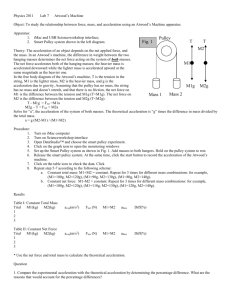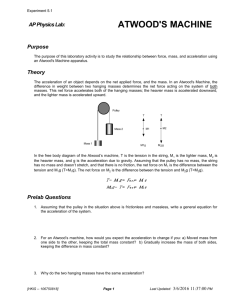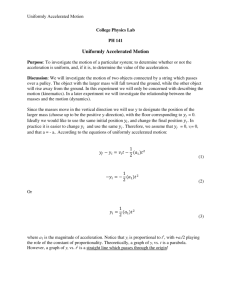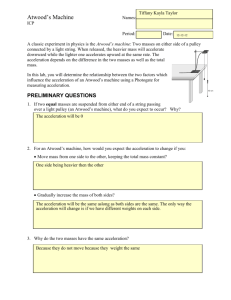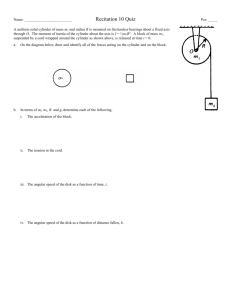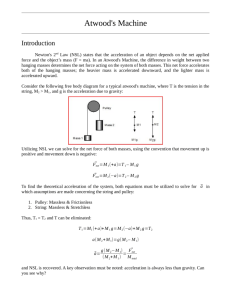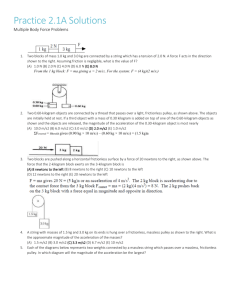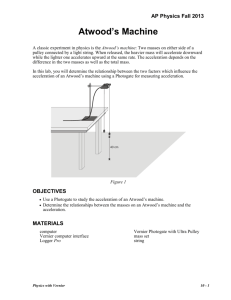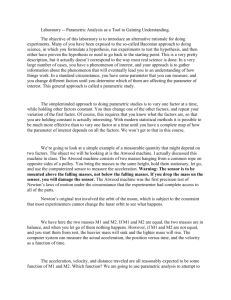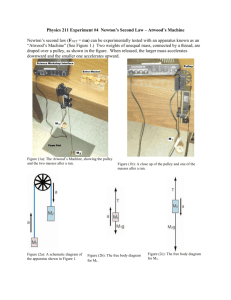Atwood Machine - Northern Illinois University
advertisement
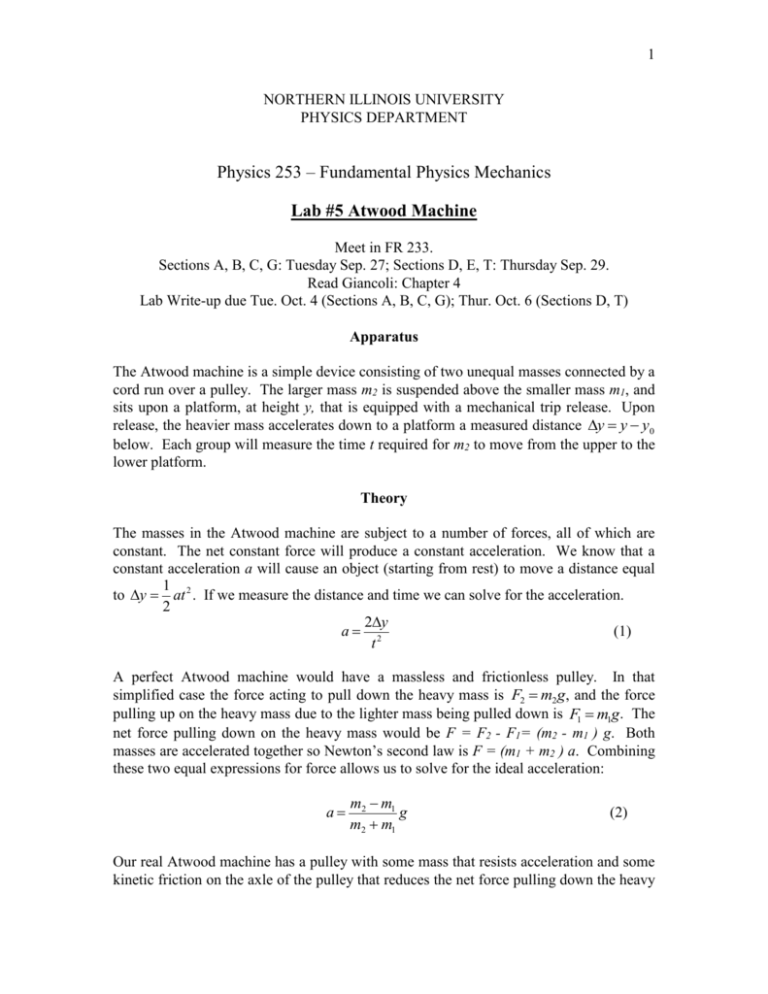
1 NORTHERN ILLINOIS UNIVERSITY PHYSICS DEPARTMENT Physics 253 – Fundamental Physics Mechanics Lab #5 Atwood Machine Meet in FR 233. Sections A, B, C, G: Tuesday Sep. 27; Sections D, E, T: Thursday Sep. 29. Read Giancoli: Chapter 4 Lab Write-up due Tue. Oct. 4 (Sections A, B, C, G); Thur. Oct. 6 (Sections D, T) Apparatus The Atwood machine is a simple device consisting of two unequal masses connected by a cord run over a pulley. The larger mass m2 is suspended above the smaller mass m1, and sits upon a platform, at height y, that is equipped with a mechanical trip release. Upon release, the heavier mass accelerates down to a platform a measured distance y y y0 below. Each group will measure the time t required for m2 to move from the upper to the lower platform. Theory The masses in the Atwood machine are subject to a number of forces, all of which are constant. The net constant force will produce a constant acceleration. We know that a constant acceleration a will cause an object (starting from rest) to move a distance equal 1 to y at 2 . If we measure the distance and time we can solve for the acceleration. 2 2y (1) a 2 t A perfect Atwood machine would have a massless and frictionless pulley. In that simplified case the force acting to pull down the heavy mass is F2 m2g, and the force pulling up on the heavy mass due to the lighter mass being pulled down is F1 m1g. The net force pulling down on the heavy mass would be F = F2 - F1= (m2 - m1 ) g. Both masses are accelerated together so Newton’s second law is F = (m1 + m2 ) a. Combining these two equal expressions for force allows us to solve for the ideal acceleration: m m1 (2) a 2 g m2 m1 Our real Atwood machine has a pulley with some mass that resists acceleration and some kinetic friction on the axle of the pulley that reduces the net force pulling down the heavy 2 mass. The mass of the pulley mp is being accelerated by the pull of the string at its rim. We will learn later in the course that a rotating disk provides an equivalent additional inertia at its rim equal to half of its mass: mp/2. For this experiment we can use mp/2 as if it were an additional mass to be accelerated with m1 and m2. How should we deal with the frictional force? If it acts like kinetic friction it should be a constant force f. If we include this as an additional force opposing the downward motion of m2 and we also include the inertia of the spinning pulley then the equation for Newton’s second law becomes: m2 m1 g f m m2 m1 p a 2 (3) In our experiment we will determine the acceleration a compared to the mass difference (m2 – m1). If we rearrange Eq. 3 to solve for a a m2 m1 f g mp m m2 m1 m2 m1 p 2 2 (4) The equation for a straight line is y x , where is the slope and is the yintercept. Eq. 4 has a similar form. If we plot a on the y-axis vs (m2 – m1 ) on the x-axis the result should be a straight line with a slope equal to g/(m1+m2+mp/2), and a yintercept at –f / ( m1 + m2 +mp/2 ). Data Collection (1) Read and record the mass of the pulley, mp, from the side of the apparatus. DO NOT REMOVE THE PULLEY FROM THE APPARATUS. (2) Put a small piece of tape (to write on) on each weight to be hung from the string. Separately measure and record in your lab notebook the mass and the uncertainty in the mass of each weight (aluminum cylinder and disks) to be hung on the strings. On the tape record just the mass. Caution: though the weights look alike, they do not have precisely the same mass. (3) Measure and record the distance (and its uncertainty) from the upper to the lower weight platform: y y y0 . (4) On one aluminum cylinder, place one 5 gram mass, three 2 gram masses, and one 1 gram masses (making a total of roughly 12 grams). Let m1 be the total mass hanging on one side of the string and m2 be the total mass hanging on the other side of the string. Record in your lab notebook m1, m2 and the mass difference m2-m1 for the first data set in grams. 3 (5) Time the fall of the heavier weight from the upper to the lower platform and record this value. (Gently catch the falling mass with your hand before it hits the metal stop—this will prevent the masses from falling off the Atwood machine). This should be repeated for a total of five trials without changing the masses. Record each trial in your lab notebook. (6) Find the average time t for the five trials and its standard error (you will need to calculate the standard deviation and the standard error of the mean). (7) Calculate the acceleration a and its uncertainty using Eq. 1 above (use the method of propagation of errors to calculate the uncertainty). Calculate the relative error (that is, the uncertainty of a divided by a). A relative error of 1% is considered a very good measurement. (8) Keeping the total mass m2-m1 the same, exchange weight(s) between the cylinders such that the mass difference m2-m1 is 10 grams instead of the current 12 grams. Record in your lab notebook your new values for, m1, m2, and the mass difference m2+m1 in grams. Repeat steps (5) through (7). (9) Repeat step (8) for mass differences of 8, 6, and 4 grams. In the end you should have a total of five sets of data, with mass differences m2-m1 of about 12, 10, 8, 6, and 4 grams, but the total mass m2+m1 is always the same. Thus the denominator in Eq. 4 is a constant (it does not vary from one measurement to another). The calculations in the Analysis section are to be finished before lab ends. You must show your final result (in Part (6)) to your TA before you leave the lab. Analysis (1) Plot in your lab notebook the acceleration a in cm/sec2 versus the mass difference m2m1 in grams for the five data sets. Note that the acceleration should be on the dependent y-axis. Include the error bars by using your uncertainty calculations in step (7) of the Data Collection section. (2) In the lab, draw by hand (using a ruler) a straight line that best fits the data points. (3) In the lab, use the graph to find the y-intercept and the slope of the line. The yintercept should be in cm/sec2 and the slope should be in cm/(g sec2). (4) Find the frictional force f on the pulley by multiplying the value of the y-intercept times the sum of the masses (see Eq. 4). Convert the value of the force to Newtons. 4 (5) Find the gravitational acceleration g by multiplying the value of the slope times the sum of masses (see Eq. 4). Convert the value of the acceleration to m/sec2. (6) Compute a percent error between your average g and 9.8 m/sec2. %Error Experimental A cceptedV alue 100 A cceptedV alue Show your result to your TA before you leave the lab. A 1% error would be very good; a 10% error is what one would expect for the instruments used in this lab. (7) For next time, hand in a complete lab write-up with a schematic of the experimental setup, equations used, data tables, a plot with a straight line fit using Excel, and a discussion of why your value of g is different than the expected value. In particular, with a careful analysis of your uncertainties, how close is your value of g to the expected value? What could be done to improve the accuracy of this measurement?
